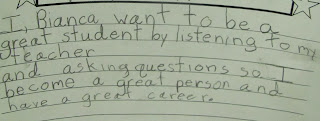There is a quote that states, "If you don't know where you are going, any road will get you there." Having a strong sense of purpose, vision and mission is researched to lead to increased student achievement and systems alignment.
Developing a classroom mission statement is based on answering three pinnacle questions: Who are we? What are we here to do? How/Why are we going to do it? This is done at each level in the district, starting at the district level through the individual student. Each mission statement aligns to the district mission statement, but is individualized to meet the differentiated needs of each school, class, and student.
Seeking stakeholder input during the development of the mission and vision of the school building and classroom is vital. Using quality tools to elicit feedback is an important part of the process. In addition, communication of the mission statement and basing decisions on the mission and vision of the district will ensure that the mission statement becomes the focus that drives improvement efforts.
Friday, December 28, 2012
Classroom Learning Communities: Establishing Ground Rules
Classroom Learning Communities should begin to be developed on the first day of school. Traditionally, teachers have posted rules, reviewed their expectations, and students sit back as passive listeners processing the same rules over the year. This tradition process fosters little accountability and student ownership. In a classroom learning community, establishing ground rules is a collaborative process that involves all students.
Using the affinity and nominal grouping techniques, students individually write their thoughts on what the ground rules should be on post-it notes. All ideas are posted and reviewed by the class. Students agree on common themes and place the ideas in groups. These groups eventually become the ground rules for the class. Once students agree on the ground rules, they are typed or written and signed by the students and teacher. The rules are then posted in the classroom data center. As the year progresses and ground rules are not followed, students and the teacher can refer to the ground rules and remind each other of the agreed-upon expectations.
In Dunlap, we have a saying that "No one escapes continuous improvement." Ground rules are established in classrooms, but also are developed by adults in Professional Learning Communities, as a faculty and in departments. The professionals hold each other accountable to these agreed upon "staff norms." These norms aren't just for teachers, but also extend to food service, custodial staff, and the transportation department as well.
In Dunlap, we have a saying that "No one escapes continuous improvement." Ground rules are established in classrooms, but also are developed by adults in Professional Learning Communities, as a faculty and in departments. The professionals hold each other accountable to these agreed upon "staff norms." These norms aren't just for teachers, but also extend to food service, custodial staff, and the transportation department as well.
Labels:
Classroom Learning Community,
collaboration,
Dunlap Grade School,
expectations,
ground rules
Subscribe to:
Comments (Atom)







